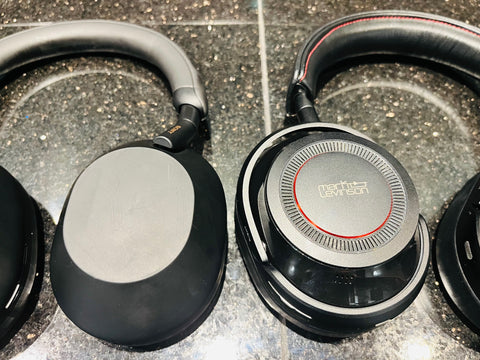Sony WH1000XM5 vs Mark Levinson No.5909 Review
by Gabby Bloch
(Updated )
Bookmark this article
Copy to clipboard
Email to a Friend

Today, we’ll be comparing two headphones on opposite sides of the price spectrum, just to see how different they are in terms of quality and bang for your buck. In terms of sound fidelity, design and functionality, just how much better is the $1000 Mark Levinson No.5909 headphone compared the best-selling and reasonably priced Sony WH-1000XM5?
In The Box
|
Sony WH-1000XM5 |
Mark Levinson No.5909 |
|
Semi-hard carrying case |
Hard shell carrying case |
|
3.5 mm cable |
4m USB-C to 3.5mm audio cable |
|
USB-C charging cable |
USB-C charging cable |
|
|
USB-C to USB-A adapter |
|
|
3.5mm to 6.3mm audio adapter |
|
|
Airplane audio adapter |
Battery Life
The XM5 has about a 30 hour battery life, as does the No.5909 when the ANC is turned on.
Bluetooth
The XM5 employs Bluetooth 5.2, while the No.5909 uses the older 5.1 version. Both headphones support a number of CODECS, including LDAC, AAC and aptX™.
Look and Feel
The No.5909 is the heavier headphone of the two models. It also has a firmer clamping force. So, for most people, the XM5 will be a more comfortable wear. The XM5 also sports a sleeker look, with mostly touch controls on the ear cup. So, if you prefer a lighter, more minimalist look, the Sony might be a better option. The No.5909 has thicker, more solid ear pads, so it’s unsurprising that the natural sound isolation is better on the No.5909.


Design and Functionality
One of the most significant differences in the technical design of these headphones lies in the drivers. While the XM5 employs standard dynamic drivers, the No.5909 has gone with beryllium, which usually outperforms dynamic drivers with respect to tightness and bass frequencies.
The WH-1000XM5 and the No.5909 are both strong players in terms of noise cancellation. Surprisingly, the No.5909 can reach a more powerful ANC level than that of the Sony. However, I find the ANC on the No.5909 a little too much when set at its highest level, as it creates a mild pressure on the ear drum. So, unless you’re looking to drown out the sound of a helicopter, both cans get the job done.
One advantage the WH-1000XM5 has over the No.5909 lies in the accompanying app. While the No.5909 has limited EQ control - only bass boost - the WH-1000XM5 allows you to control the entire frequency range, even offering custom presets. For people who love to play around with their balance, this is a huge plus over the No.5909.
As mentioned above, the XM5 is designed with touch controls on the ear cup. For some, this element may be more attractive than the No.5909’s standard buttons. But if you hate to fiddle around with taps and swipes, you may get frustrated with the control pad on the XM5.

Soundstage
The results are surprising in this category. If you listen carefully to the two headphones side by side, there are of course differences in the soundstage profile. The No.5909 definitely presents a more grand and life-like feel. And the No.5909 is perhaps more nuanced in its instrument placement. But the XM5 is certainly no slouch, especially considering the significantly lower price. It too offers a generous stage with plenty of color in terms of left to right imaging.
Low End
The XM5 presents a thick and creamy low end, while the No.5909 takes a more conservative approach that sounds significantly more natural and nuanced. Again this is unsurprising given the noteworthy difference in price and design.
When it comes to the sub frequencies, the No.5909 feels more extended, giving the listener a more visceral experience. So, if you listen to a lot of hip-hop and really appreciate that subby feel, the No.5909 would be the winner.
Mids
Both headphones convey a very balanced sound in the mids, giving plenty of body and fullness to tracks with a busy midrange. But it’s hard to ignore the relatively sloppy bass frequencies of the XM5, which to tend to overpower or bleed into the details if the middle frequencies. And again, the level of articulation on the No.5909 is far superior.
Highs
Although you’ll get plenty more detail from the No.5909 in the highs, the XM5 offers a rounder and more forgiving sound, as it has a light roll-off in the higher frequencies. So, for example, if you listen to a lot of jazz trumpets and suffer from a bit of tinnitus, the XM5 may be preferable for longer listening stretches.
Summary
Although the balance on both headphones makes for a smooth and easy listening experience, ultimately, we are comparing apples to oranges in terms of sound quality. That being said, if you’re looking for the fairest deal, the XM5 offers a hell of a lot with respect to functionality and overall sound quality. But for uncompromising audiophiles, the far superior skills of the No.5909 just might be worth the extra 500 bucks. Still, this is a Bluetooth headphone, and most audio fanatics tend to forego the convenience of a wireless connection for the high-fidelity sound of a wired headphone in this price range. So, it’s a good idea to consider where and when you will be listening to your Bluetooth cans. If you’re using your wireless headphones for a short commute or to eliminate the chatter of your colleagues, the XM5 will probably do fine.
You can find both headphones here:

Get the Latest Headphone News and Reviews in Your Inbox
Subscribe to our newsletter and get 10% off your first purchase!*
*some restrictions may apply


 FREE
FREE 


